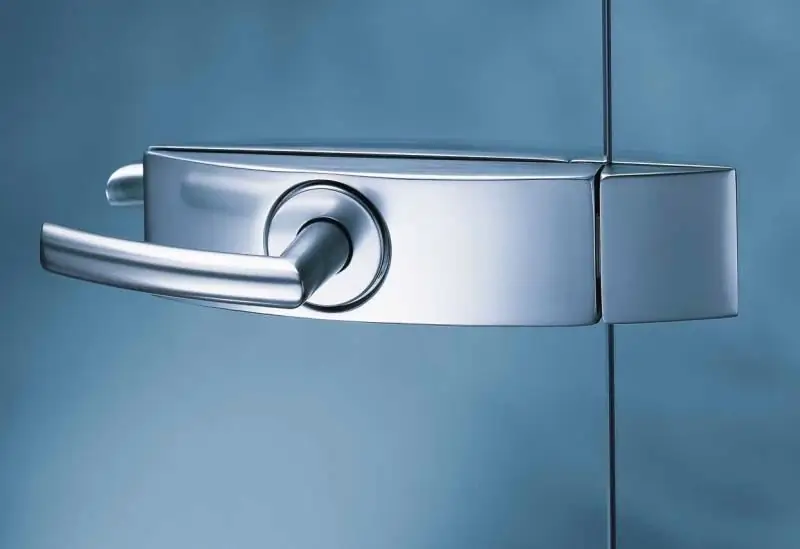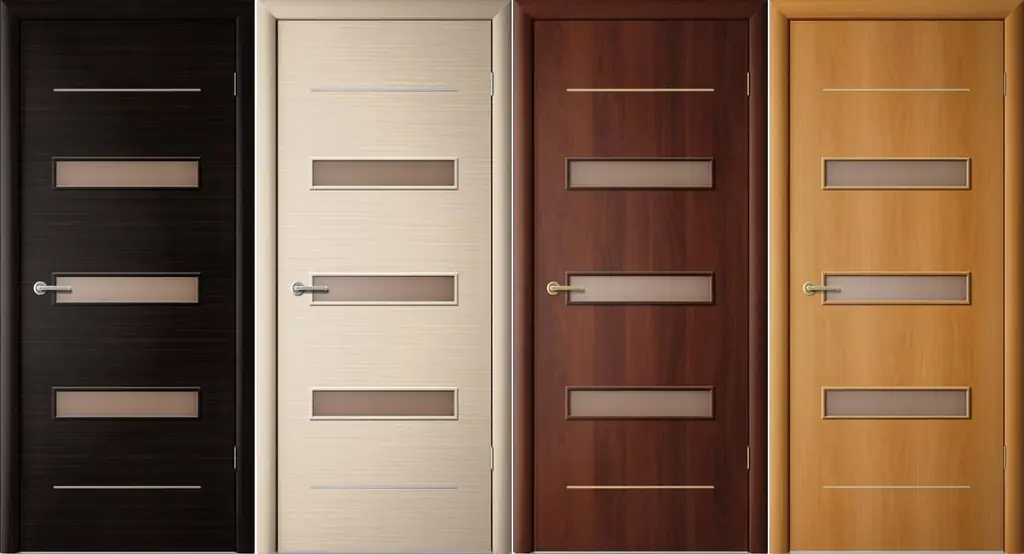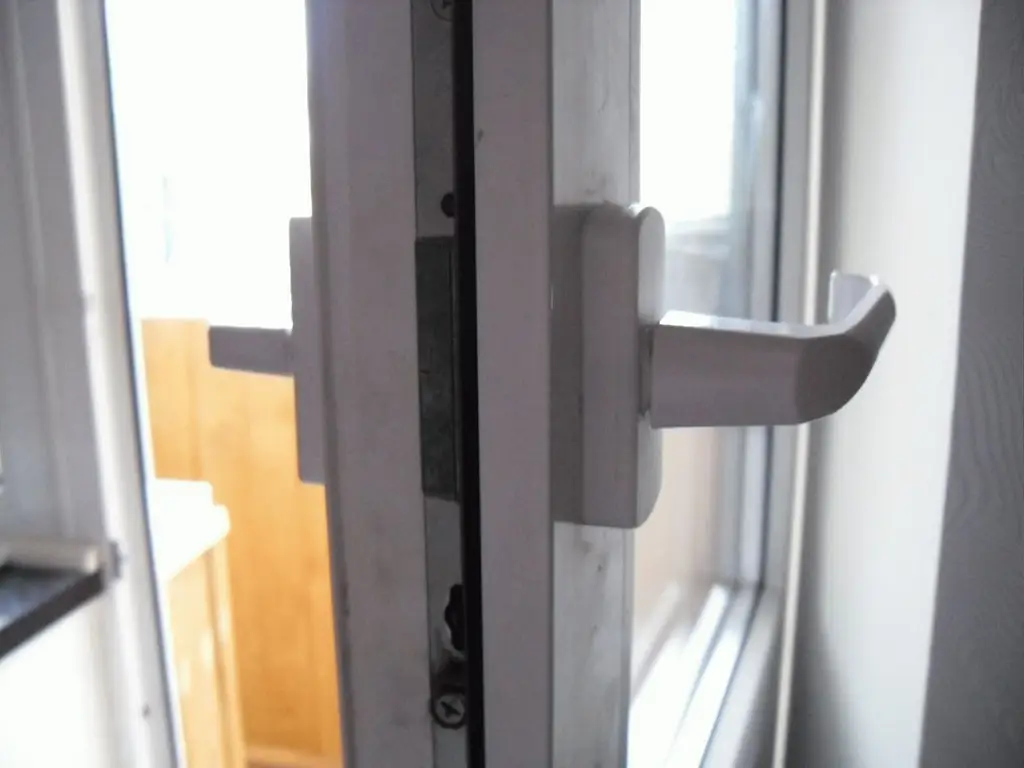
Table of contents:
- Author Bailey Albertson [email protected].
- Public 2023-12-17 12:53.
- Last modified 2025-01-23 12:41.
Locks for glass doors, types and features of selection, installation, repair

Glass door structures are increasingly used in the interiors of residential, office, retail and administrative premises. They look light and modern, let in maximum light and visually expand the space. In order for glass doors to perform their functions efficiently, special fittings are used for their installation, including locks. Features of locking mechanisms for glass doors are due to the specifics of the glass itself, a beautiful and durable material, but fragile.
Content
-
1 Types and main characteristics of locks for glass doors
- 1.1 Features of mortise locks
- 1.2 Features of overhead locks
- 1.3 Video: Glass Door Lock
- 2 Things to Consider When Choosing a Glass Door Lock
-
3 Installing a lock on a glass door
3.1 Video: Glass door lock installation
- 4 Glass door lock repair
- 5 Removing the glass door lock
- 6 Reviews
Types and main characteristics of glass door locks
Depending on the installation principle, there are 2 types of locking devices for glass doors:
- mortise;
-
waybills.

Glass door lock Glass door lock can be mortise or overhead
Features of mortise locks
Mortise mechanisms require drilling holes in a glass door leaf for installation (it is done with diamond drills, this is a job for highly qualified specialists).
There are several types of mortise locks:
- cylinder (opened with a key on both sides, used for swing models);
- with a latch (they work thanks to a spring mechanism that pushes the plate that locks the door);
- with a latch (make it possible to block the door from one side);
- with a counterpart (for door systems with two leaves, the product has a main part with a cylinder and a counterpart, where the bolt is located when the door is locked).
The advantage of mortise locks is their high resistance to burglary and neat appearance (the locking mechanism is hidden inside the case). The simplest solution, used as a locking mechanism for showcases and swing doors, is just rotary mortise locks.

Burglar-proof mortise lock
The disadvantages include the complexity of installation of mortise-type locks due to the fragility of the glass in combination with its high hardness. Special equipment will be required if the thickness of the door leaf exceeds 1 cm or if its surface is coated with a compound to increase its strength. But even if special equipment is used to install the mortise lock and highly qualified specialists are involved in the installation work, it is impossible to guarantee that the glass will retain its strength if the integrity of the canvas is violated by drilling.
Features of overhead locks
In the overhead mechanisms, special clamping strips are used for fixing and no drilling is required. It is a modern alternative to mortise devices.
The main types of glass door locks without drilling:
- mechanical;
- electromechanical;
- electronic (digital);
- electromagnetic.

Padlock with lever handle does not require drilling in the door leaf
Mechanical models attract with their compactness, variety of designs, resistance to burglary attempts. Moreover, they do not depend on the power supply. Overhead mechanical locks can be cylinder, rack and pinion, with a latch or a latch. Rack models are interesting in that the obturator is completely removed from the door leaf after opening the door. Such a lock is installed in place only when the door is closed.
Electromechanical locks are distinguished by the fact that the locking mechanism is electrically activated here and there is no need to use keys. This function is convenient for glass doors, it protects the canvas from chips, scratches, fingerprints. The advantage of an electromechanical lock is that in such a device there is no friction between metal parts, they are not subject to wear and tear and are resistant to burglary attempts.

Electromechanical lock requires no keys
Electronic or digital models are opened using a digital code. You need to type it on a special panel. On the reverse side there is a latch that blocks the sash from the inside. The disadvantages of this type of locks include their dependence on electricity and relatively high prices.

An electronic glass door lock is convenient but can be expensive
Electromagnetic devices are the most modern type of locking mechanisms for glass door structures. They function thanks to the magnetic field that is created between the core and its armature in the counterpart of the device. When the key is used or the opening button is pressed, the field disappears due to a power outage and the door can be opened. This model is suitable if the lock is mounted above the opening or in the upper part of the door leaf.
The disadvantages of the electromagnetic lock include the large size and weight of the device, as well as the need for constant power supply.
For sliding glass showcase doors, models with a removable cylinder are often used. This is an elegant and popular solution.
A similar lock is mounted by fixing the body in the form of a washer on the door leaf in a special opening. On the reverse side, a special sleeve is attached to the body. The cylinder mechanism is inserted into the prepared hole and fixed inside the body with a key, the door leaf closes. Such devices involve the removal of both the larva and the key.

Striker lock suitable for double glass doors
Video: glass door lock
Things to Consider When Choosing a Glass Door Lock
When choosing a locking mechanism, pay attention to the study of the following characteristics of the device:
- design, appearance, build quality;
- parameters of glass for which the lock is intended (for example, glass thickness must be at least 5 mm);
- burglar resistance class.
Installing a lock on a glass door
Installing a lock on a glass door is a difficult task. This is due to the increased fragility of the material, while it is very hard and homogeneous. The minimum glass thickness for installing locks should be 5 mm.
The technology for installing mortise and overhead products varies significantly. For this you need:
- Determine the location of the device on the door and mark the locations of the holes that need to be drilled to fix the product on the door leaf.
- For mortise locks, holes must be drilled in the glass to install the device elements. This requires special equipment, namely: a hand-held router and drills with a diamond coating or with a diamond cutting edge. This is important, since only with such elements it is possible to make a hole without damaging the fragile material.
- When drilling a glass surface, the working area of the drill requires cooling. To do this, use special emulsions. This is the only way to get clean holes for high-quality fastening of the lock elements.
- The details of the lock are fixed on the glass sheet through the holes prepared in the previous stages, according to the instructions. The product is being assembled.
- At the last stage, the operability of the device as a whole is checked.
Installation of overhead models is less time consuming and complicated. There is a special plate in overhead locks. It is put on a glass sheet and fastened with screws, which are fixed in the holes on the pressure plate. The screws press the lock tightly to the door leaf. For maximum safety, additional plastic pads can be used.
Video: installing a lock for a glass door
youtube.com/watch?v=TC6w204FrCA
Glass door lock repair
Over time, the lock may need to be repaired. The most common types of problems:
- the lock starts to open and close tightly, the key can be turned with difficulty (in locks with a "larva" / core);
- the case breaks;
- the locking tab cannot slam shut;
- the lock jams when opening / closing the sash.
If the case breaks down, you will need a screwdriver for repair. With its help, the fastening bolts are unscrewed and a new one is installed instead of the broken case (for overhead options). When working with a mortise mechanism, all elements are sequentially dismantled. Tweezers and a soft cloth remove all dirt and dust accumulated inside, the deformed parts must be replaced with new ones. You also need to check the operability of the locking mechanism itself, since the problem could arise not only due to the broken case.
If, when closing the sash, the locking tab does not allow the door to be closed, this may be due to the too small size of the mating hole. You will need to bore it, observing the maximum accuracy, and move the plate to the desired position. The lining on the end of the door or the skew of the door leaf can prevent the tongue from working correctly. In addition, the device will wear out over time and parts may come loose. In the latter case, each of them must be carefully fixed.

It is better to hire a specialist to repair the glass door lock.
When the cylinder lock is jammed, the problem may lie in the breakage of the cylinder or the lock core. In this case, you will need to remove the outer plate of the body, remove the main bolt, remove the cylinder with a drill or key. Then you need to install a new core (it should be completely the same as the previous one) and fix it with special screws, return the case plate to its original place.
If the lock sticks, and the key is difficult to turn inside, then a possible problem may be that some parts of the locking mechanism have moved. You need to carefully disassemble the lock with a screwdriver, clean and lubricate its parts, and put it back in place.
Also, the cause of the problem may lie in the breakdown of the counterpart of the device. The repair consists in boring the counter plate or fixing it in the correct position. Replacement may also be required. If you can't fix the malfunction on your own, then you can always contact a repair specialist.

Glass door lock repair must be done carefully
Removing the glass door lock
If you need to clean, replace or repair the glass door lock, you will need to dismantle it. How to remove the lock from the door leaf? The answer depends on the type of lock.
Dismantling the padlock will not be difficult. It is necessary to unscrew the fixing screws and remove it, as well as the pressure plate.
To remove a mortise lock, you need:
- Disassemble the door handles by removing the decorative strip and unscrewing the fixing elements with a screwdriver.
- The next step is to get the larva (core) of the castle. To do this, unscrew the central bolt on the end plate. To prevent the protective mechanism holding the larva from working, you need to insert the key into the well and turn it slightly clockwise.
- At the final stage, 2 bolts are unscrewed along the edges of the end plate.
Reviews
Manufacturers offer a wide range of locking devices designed for glass doors. On sale you can find both inexpensive compact models for interior designs, and ultra-modern mechanisms with a high degree of protection, remote electronic control and stylish design. Your choice should be made based on the parameters of the door system, the required safety class and the appearance of the device. Models of overhead locks for glass doors are used especially widely, but mortise elements are also permissible for use with strict adherence to the installation technology.
Recommended:
How To Build A Glass Greenhouse With Your Own Hands: Which Is Better, Glass Or Polycarbonate, Step-by-step Instructions With Photos, Videos And Drawings

Making a glass greenhouse with your own hands: material features, recommendations for choosing glass, calculations. Detailed construction technology. Useful Tips
Interior Laminated Doors And Their Varieties With A Description And Characteristics, Advantages And Disadvantages, As Well As Use And Compatibility In The Interior

What are laminated doors: varieties and their characteristics. How to choose and install doors. Tips for the operation and repair of laminated doors
Locks For Plastic Doors: Which Are Better To Use And How To Install Correctly

The main types of locks for plastic doors. Rules and sequence of work for the installation and dismantling of such locks
Door Locks: Types And Their Characteristics, How To Choose And Install Correctly, As Well As A Rating For Reliability

Varieties of door locks. How to choose the most reliable device. Do-it-yourself door lock installation and repair. Operating tips
Door Locks For Metal Doors: Characteristic Of Varieties, How To Choose And Install Correctly

Varieties of locks for metal doors, their design, pros and cons. DIY installation of mortise and overhead locks. Maintenance and repair
